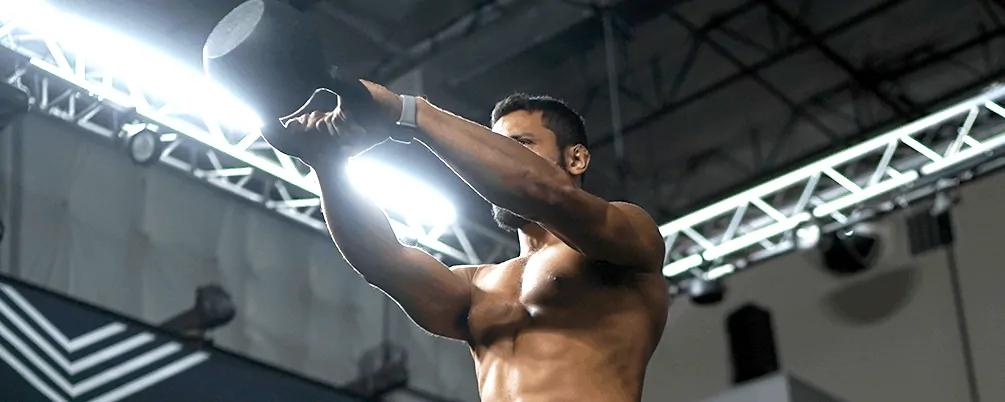
Often referred to as the “Kettlebell Cold War,” the debate over which swing is better, the American or Russian, continues even today 2020.
While we can rest assured we most likely won’t have to defend our point of view on the subject with our lives, it helps for any kettlebell enthusiast to know the clear differences between each swing so he/she can judge for themselves which works best.
American vs. Russian Kettlebell Swings: Key Differences

Interestingly, for all of the debate about which swing is superior, the movement pattern of each is identical except for the top position. Both start the swing with the kettlebell just below the groin, and, using a slight flexion of the knee and powerful thrust of the hips, push the kettlebell into its apex, all the while keeping the spine straight and neutral.
In both movements, the core is also braced, the glutes are thoroughly engaged, and the shoulders and lats are stable.
Russian Kettlebell Swing

The photo above illustrates the key difference between the Russian and American swing. Here, the apex of the swing is at shoulder height, rather than overhead.
The arguments for the superiority of the Russian swing are good ones. The foremost is that it allows the swinger to move a heavier bell due to not having to worry about carrying that weight fully overhead (which could be dangerous for the shoulder joints and spine), and can thus increase power output.
In addition, Russian swings are typically performed faster than American swings because it takes roughly half the time to reach the apex of the shoulders than the apex of overhead. So here we have the advantage of heavier weight increasing hip power output, as well as decreased rep time. Not to mention, the stop of the weight at the shoulder trains athletes to stop with their abs and glutes, and also requires more of the lat muscles to stop the swing.
One of the arguments against the Russian swing is that it causes you to perform less “work” by limiting the range of the swing to shoulder height, but when you consider the weight and muscle recruitment trade-off, the argument starts to fade.
American Kettlebell Swing

As you’ve probably gathered, the American swing extends the apex of the Russian swing to overhead, in direct alignment with the spine. The main argument for this is that it requires more “work” (increased heart rate/energy output) than its Russian counterpart.
In an article from the CrossFit Journal titled, ‘The Kettlebell Swing’, CrossFit Founder and CEO Greg Glassman presents his argument for why the American swing should be the primary training method, stating:
“We don’t do half rep pull-ups, we don’t do half rep squats, and we don’t do half rep push-ups. If there is a natural range of motion to any movement we like to complete it. To do otherwise seems unnatural. We would argue that partial reps are neurologically incomplete,” and “More work in less time, or more weight moved farther in less time, is largely a measure of an exercise’s potency. When we swing the kettlebell to overhead … we nearly double the range of motion compared to the Russian swing and thereby double the work done each stroke. For any given time period, the power would be equivalent only if the Russian swing rate was twice the American swing rate.”
While this statement is true, we discussed earlier that much of the “work” is replaced elsewhere with Russian swings, such as in having to move a heavier weight, along with faster reps and training “stopmotion” in the abs, glutes, and lats, which has tons of benefits in sports situations where quick stop-go movements are required.
So. Who Wins?

Overall, I tend to lean toward Russian swings for the simple fact that they allow you to move a heavier weight and decrease the chances of, to put it bluntly, screwing up your shoulders or spine.
However, with that being said, having a balance between both type of swings in your regime is actually the best trade off. Both train different areas and principles, therefore by using both you develop more holistically strong movement patterns. Here, American gives you the range and a different work output, while Russian gives you a power boost and stop-training.
So at the end of the day, I say cheers to mastering both. And why not? As long as you don’t have a weak shoulder or injury preventing you from doing American swings, there’s no reason to avoid them totally. This mindset typically goes for most training methods, as they often cross-pollinate one another to create more holistic strength. Kind of like how yoga or mobility exercises (while not appearing to be related to kettlebell training in any way) actually benefit your range of motion, balance, and flexibility like nothing else.
What are your thoughts? Have you tried both swings?
Totally agree, Dude!! American swing presents a lot of opportunity for unnecessary injury.
Practical approach…Very informative
I feel like if I’m going for a certain amount of reps (usually heavier) I will use the Russian swing, however if I’m going for a certain amount of time (usually a lighter weight) I will use the American swing.
I definitely prefer Russian hard style swings. In regards to what Glassman said, no hate on people who do CrossFit but I do find it ironic that he’s talking about exercise ‘complete range of motion’ and yet they advocate for kipping pull ups. Range of motion and strict form are two sides of the same coin.
I prefer Russian. The point of the exercise is leg and core. The second half of the American swing is mainly momentum from the Russian swing and you have to go lighter to mitigate risk. The risk reward profile isn’t worth it to me. I’d rather crush legs and core with heavier weight and get more cardio with faster reps.
I say Russian Swings are superior + less potential for injury. If one is eager to go overhead, then snatch is the way to go. Snatch is far superior to American swing